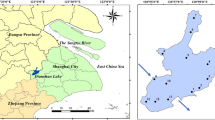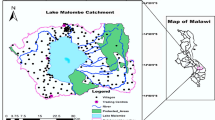Abstract
With the aquatic environments being excessively stressed by human activities, the need for monitoring critical quality parameters continuously and at large spatial scales is greater than ever. Tο this end, the goal of this study was to exploit remote sensing data for water quality estimation towards the development of a long-term monitoring protocol for aquatic systems. High resolution, multitemporal data were employed along with in-situ measurements for key water quality parameters. After establishing relations between the satellite and in-situ data, multitemporal geospatial maps of Lake Karla were produced and validated, indicating that the observed chlorophyll-α is fluctuating throughout the year. In particular, a high correlation rate (r2 > 89 %) for Chl-a was derived through a linear regression model while certain mismatches occurred due to frequent cyanobacterial blooms that were mainly observed in the quite shallow parts of the lake. Moreover, the spatiotemporal analysis revealed a gradual slight decline in average chlorophyll-α concentrations from the beginning of 2011 and onward. The lake regions which were affected the most were the shallow ones, so it is necessary to better distribute the sampling locations within the lake in order to better quantify the fluctuations of water quality parameters. By exploiting high resolution satellite imagery, the proposed methodology implements a low-cost water monitoring system which enables the frequent update of important water quality parameters of any relevant geo-database, towards the efficient development of water management plan for protection and restoration of sensitive aquatic ecosystems.



Similar content being viewed by others
References
Bresciani M, Stroppiana D, Odermatt D, Morabito G, Giardino C (2011) Assessing remotely sensed chlorophyll-a for the implementation of the water framework directive in European perialpine lakes. Sci Total Environ 409:3083–3091
Brezonik P, Menken KD, Bauer M (2005) Landsat-based remote sensing of lake water quality characteristics, including chlorophyll and colored dissolved organic matter (CDOM). Lake and Reservoir Management 21:373–382
Brezonik P, Olmanson L, Finlay J, Bauer M (2015) Factors affecting the measurement of CDOM by remote sensing of optically complex inland waters. Remote Sens Environ 157:199–215
Carlson RE (1977) A trophic state index for lakes. Limnol Oceanogr 22:361–369
Chamoglou M, Papadimitriou T, Kagalou I (2014) Key-descriptors for the functioning of a Mediterranean reservoir: the case of the new Lake Karla-Greece. Environ Process 1:127–135
Chen Z, Hu C, Muller-Karger F (2007) Monitoring turbidity in Tampa Bay using MODIS/aqua 250-m imagery. Remote Sens Environ 109:207–220
Dash P, Walker N, Mishra D, Hu C, Pinckney J, D’Sa E (2011) Estimation of cyanobacterial pigments in a freshwater lake using OCM satellite data. Remote Sens Environ 115:3409–3423
Giardino C, Pepe M, Brivio PA, Ghezzi P, Zilioli E (2001) Detecting chlorophyll, Secchi disk depth and surface temperature in a sub-alpine lake using Landsat imagery. Sci Total Environ 268:19–29
Giardino C, Brando V, Dekker A, Strömbeck N, Candiani G (2007) Assessment of water quality in Lake Garda (Italy) using Hyperion. Remote Sens Environ 109:183–195
Gons HJ, Rijkeboer M, Ruddick KG (2002) A chlorophyll-retrieval algorithm for satellite imagery (medium resolution imaging spectrometer) of inland and coastal waters. J Plankton Res 24:947–951
Gons H, Auer M, Effler S (2008) MERIS satellite chlorophyll mapping of oligotrophic and eutrophic waters in the Laurentian Great Lakes. Remote Sens Environ 112:4098–4106
Heddam S (2016) Secchi disk depth estimation from water quality parameters: artificial neural network versus multiple linear regression models? Environ Process. doi:10.1007/s40710-016-0144-4
Hellweger FL, Miller W, Oshodi KS (2007) Mapping turbidity in the Charles River, Boston using a high-resolution satellite. Environ Monit Assess 132:311–320
Jay S, Guillaume M (2014) A novel maximum likelihood based method for mapping depth and water quality from hyperspectral remote-sensing data. Remote Sens Environ 147:121–132
Koponen S, Pulliainen J, Kallio K, Hallikainen M (2002) Lake water quality classification with airborne hyperspectral spectrometer and simulated MERIS data. Remote Sensing of Environmnet 79:51–59
Kutser T (2004) Quantitative detection of chlorophyll in cyanobacterial blooms by satellite remote sensing. Limnology & Oceanography 49:2179–2189
Kutser T, Pierson D, Kallio K, Reinart A, Sobek S (2005) Mapping lake CDOM by satellite remote sensing. Remote Sens Environ 94:535–540
Lesht M, Barbiero P, Warren J (2013) A band-ratio algorithm for retrieving open-lake chlorophyll values from satellite observations of the Great Lakes. J Great Lakes Res 39:138–152
Luo J, Li X, Ma R, Li F, Duan H, Hu W, Qin B, Huang W (2016) Applying remote sensing techniques to monitoring seasonal and interannual changes of aquatic vegetation in Taihu Lake, China. Ecol Indic 60:503–513
Majozi NP, Salama S, Bernard S, Harper DM, Habte MG (2014) Remote sensing of euphotic depth in shallow tropical inland waters of Lake Naivasha using MERIS data. Remote Sens Environ 148:178–189
Matthews M, Bernard S, Winter K (2010) Remote sensing of cyanobacteria-dominant algal blooms and water quality parameters in Zeekoevlei, a small hypertrophic lake, using MERIS. Remote Sens Environ 114:2070–2087
Matthews M, Bernard S, Robertson L (2012) An algorithm for detecting trophic status (chlorophyll-a), cyanobacterial-dominance, surface scums and floating vegetation in inland and coastal waters. Remote Sens Environ 124:637–652
McCullough I, Loftin C, Sader S (2012) Combining lake and watershed characteristics with Landsat TM data for remote estimation of regional lake clarity. Remote Sens Environ 123:109–115
Meguro H, Toba Y, Murakami H, Kimura N (2004) Simultaneous remote sensing of chlorophyll, sea ice and sea surface temperature in the Antarctic waters with special reference to the primary production from ice algae. Adv Space Res 33:1168–1172
Mellios N, Kofinas D, Laspidou C, Papadimitriou T (2015) Mathematical modeling of trophic state and nutrient flows of Lake Karla using the PCLake model. Environ Process. 2:85–100. doi:10.1007/s40710-015-0098-y
Nellis D, Harrington J Jr, Wu J (1998) Remote sensing of temporal and spatial variations in pool size, suspended sediment, turbidity, and Secchi depth in Tuttle Creek reservoir, Kansas: 1993. Geomorphology 21:281–293
Nobuhle P, Mhd M, Salama S, Bernard S, Harper MD, Habte MG (2014) Remote sensing of euphotic depth in shallow tropical inland waters of Lake Naivasha using MERIS data. Remote Sens Environ 148:178–118
OECD (1982) Eutrophication of waters: monitoring, assessment and control. Organisation of Economic Cooperation and Development, Paris 154
Olmanson L, Bauer M, Brezonik P (2008) A 20-year Landsat water clarity census of Minnesota's 10,000 lakes. Remote Sens Environ 112:4086–4097
Olmanson L, Brezonik P, Bauer M (2013) Airborne hyperspectral remote sensing to assess spatial distribution of water quality characteristics in large rivers: the Mississippi River and its tributaries in Minnesota. Remote Sens Environ 130:254–265
Palmer SCJ, Odermatt D, Hunter PD, Brockmann C, Présin M, Balzter H, Tóth VR (2015) Satellite remote sensing of phytoplankton phenology in Lake Balaton using 10 years of MERIS observations. Remote Sens Environ 158:441–452
Papadimitriou T, Katsiapi M, Kormas KA, Moustaka-Gouni M, Kagalou I (2013) Artificially-born “killer” lake: phytoplankton based water quality and microcystin affected fish in a reconstructed lake. Sci Total Environ 452-453:116–124
Pozdnyakov D, Shuchman R, Korosov A, Hatt C (2005) Operational algorithm for the retrieval of water quality in the Great Lakes. Remote Sens Environ 97:352–370
Sidiropoulos P, Papadimitriou T, Stabouli Z, Loukas A, Mylopoulos N, Kagalou I (2012) Past, present and future concepts for conservation of the re-constructed Lake Karla (Thessaly-Greece). Fresen Environ Bulletin 21:3027–3034
Tebbs EJ, Remedios JJ, Avery ST, Rowland CS, Harper DM (2015) Regional assessment of lake ecological states using Landsat: a classification scheme for alkaline–saline, flamingo lakes in the east African Rift Valley. Int J Appl Earth Obs Geoinf 40:100–108
Tsakiris G (2015) The status of the European waters in 2015: a review. Environmental Processes 2:543–557
Wang F, Han L, Kung HT, Van Arsdale RB (2006) Applications of Landsat-5 TM imagery in assessing and mapping water quality in Reelfoot Lake, Tennessee. Int J Remote Sens 27:5269–5283
Wilkie C, Scott M, Miller C, Tyler A, Hunter P, Spyrakos E (2015) Data fusion of remote-sensing and in-lake chlorophyll-a data using statistical downscaling. Procedia Environmental Sciences 26:123–126
Wrigley R, Horne A (1974) Remote sensing and lake eutrophication. Nature 250:213–214
Zheng Z, Yuanling Z (2011) Research on the water quality monitoring system for inland lakes based on remote sensing. Procedia Environmental Sciences 10:1707–1711
Acknowledgments
Authors are thankful to Ms. Mariantzela Patelakis for her valuable help in remote sensing data processing. An initial version of this paper has been presented at the 9th World Congress of the European Water Resources Association (EWRA) “Water Resources Management in a Changing World: Challenges and Opportunities”, Istanbul, Turkey, June 10-13, 2015.
Author information
Authors and Affiliations
Corresponding author
Rights and permissions
About this article
Cite this article
Theologou, I., Kagalou, I., Papadopoulou, M.P. et al. Multitemporal Mapping of Chlorophyll–α in Lake Karla from High Resolution Multispectral Satellite data. Environ. Process. 3, 681–691 (2016). https://doi.org/10.1007/s40710-016-0163-1
Received:
Accepted:
Published:
Issue Date:
DOI: https://doi.org/10.1007/s40710-016-0163-1




